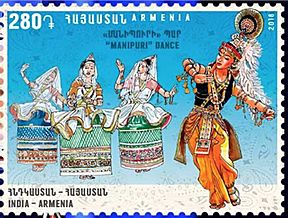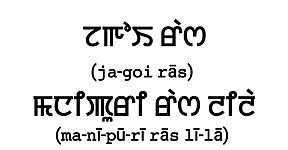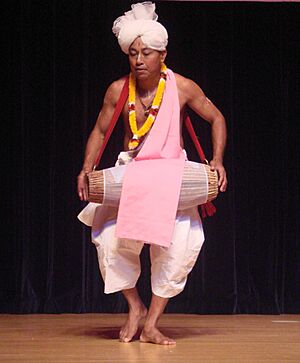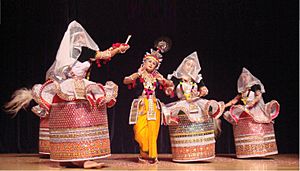Manipuri Raas Leela facts for kids
|
An illustration of the Manipuri Raas Leela dance, being depicted in a stamp from Armenia; transliterations of "Jagoi Raas" and "Manipuri Raas Leela", the terms in Meitei language (officially called Manipuri) and Sanskrit respectively, for the Manipuri classical dance, in Meitei script (Manipuri script) of medieval era
|
|
| Native name | Meitei: Jagoi Raas, Raas Jagoi |
|---|---|
| Etymology | "Raas Leela of the Manipuris" |
| Genre | Indian classical dance |
| Inventor | Rajarshi Bhagyachandra (Meitei: Ching-Thang Khomba) |
| Origin |
|
The Manipuri Dance, also known as the Manipuri Raas Leela, is a beautiful classical dance form. It comes from the state of Manipur in India. This dance is one of the eight main classical Indian dance styles.
Manipuri dance is known for its gentle movements and peaceful facial expressions. It often shows devotion, especially to the Hindu deities Radha and Krishna. The dance tells stories of their divine love, like the famous Raas Leela.
Like other classical Indian dances, Manipuri dance has ancient roots. It is connected to the old Hindu text Natya Shastra. Over time, it mixed with local folk dances. This dance form was passed down through generations by word of mouth. Unlike some other dances, Manipuri dance was always seen as respectable.
This dance is mostly religious and feels very spiritual. It uses special devotional music. Instruments like cymbals (kartal or manjira) and a double-headed drum (pung or Manipuri mrdanga) set the beat. The dance often tells stories from Vaishnavite Padavalis, which are religious songs and poems.
While Manipuri Dance is often linked to the Raas Leela, it also includes other styles. These are jagoi, cholom, and huyen langlon. Huyen langlon is unique because it's one of the few Indian classical dances that shows fighting.
Contents
History of Manipuri Dance
The first written records about Manipuri dance are from the early 1700s. However, the dance form is much older.
Early Development
Ancient texts from Manipur are hard to find today. So, we learn about the dance's early history from oral stories and old Asian writings.
In the 1400s, Vaishnavism, a branch of Hinduism, came to Manipur. Later, more Hindus arrived from other parts of India. In 1704, King Pitambar Charairongba made Vaishnavism the state religion. Then, in 1717, King Gareeb Niwaz became a follower of the Chaitanya style of Vaishnavism. This style focused on singing, dancing, and religious performances about the Hindu god Krishna. By 1734, dance dramas about the Hindu god Rama also became part of Manipuri dance.
King Rajarshi Bhagyachandra (who ruled from 1759 to 1798) was very important. He was a follower of Krishna and helped organize and improve the Manipuri dance style. This time was like a "golden age" for the dance. He created three of the five main Raas Leelas: the Maha Raas, Basanta Raas, and Kunja Raas. He also designed the special Kumil costume, which is a long, stiff skirt that makes dancers look like they are floating. King Bhagyachandra also started public performances of these dances in Hindu temples.
Later kings also added to the dance. King Gambhir Singh (ruled 1825–1834) created two parengs (dance sequences) that were more energetic. King Chandrakirti Singh (ruled 1849–1886) was a skilled drummer. He created many Pung choloms (drum dances) and two more gentle parengs.
British Rule and Revival
In 1891, the British took control of Manipur. This slowed down the development of Manipuri dance. Like other classical Indian arts, it was sometimes seen as old-fashioned. However, the dance and its artists kept going, especially in temples like the Shree Govindajee Temple in Imphal.
The dance got a new boost thanks to Rabindranath Tagore, a famous Indian writer. In 1919, he saw a Manipuri dance performance and was very impressed. He invited teachers (Gurus) of Manipuri dance to his school, Shantiniketan. These Gurus helped Tagore create many dance-dramas. This helped the dance become popular again.
Dance Styles and Stories
Chali or Chari is the basic movement in Manipuri Raas dances. The dances are often performed on full moon nights. This happens three times in autumn and once in spring.
Themes and Characters
The Basanta Raas is performed during the spring festival of Holi. Other dances are for post-harvest festivals like Diwali. The songs and stories in the dances are about the love between Radha and Krishna. They also feature the Gopis, who are cowherd girls. Each Gopi has her own dance part. The words in the songs often have both a simple meaning and a deeper spiritual meaning.
The longest part of the dance usually focuses on Radha and Krishna. The dancer playing Krishna shows different feelings. The Gopis use their body language and hand gestures to show emotions like longing or joy.
Some Manipuri dances are more energetic and acrobatic. For example, in Gopa Ras, many boys dance together. They act out daily tasks like feeding cows. Uddhata Akanba is a dance full of jumps, squats, and spins, showing lots of energy and grace.
Costumes
Manipuri dance has very special costumes. Female dancers wear doll-like Potloi costumes. Legend says that King Rajarshi Bhagyachandra dreamed of this beautiful costume.
Female Costumes
- Choli: This is a velvet blouse worn on the upper body. It's decorated with fancy embroidery. Gopis usually wear red blouses, while Radha often wears green.
- Kumin: This is a long, barrel-shaped skirt. It's stiff at the bottom and decorated with gold and silver embroidery. It also has small mirrors and patterns of flowers.
- Pasuan: A wavy, see-through muslin skirt worn over the Kumin. It's tied in a special way.
- Khangoi: A small rectangular belt worn over the Pasuan.
- Khaon: A rectangular embroidered piece with a belt.
- Thabret: A girdle worn around the waist.
Dancers do not wear bells on their ankles. Instead, they wear anklets and foot ornaments. They also wear necklaces and decorate their face, back, waist, hands, and legs with round jewelry or flower garlands. Their faces are often decorated with a special mark (Tilak) on the forehead. The see-through dress makes the dancers look like they are floating on stage.
Head Accessories
- For Females: Koknam (a gauze cloth with silver designs), Koktombi (a cap), and Meikhumbi (a thin, clear veil).
- For Males: Leittreng (Kajenglei) (a golden headdress) and Chura (made of peacock feathers).
Male Costumes
Male dancers wear a dhoti, which is a brightly colored cloth wrapped around the waist. This allows them to move freely. Dancers playing Lord Krishna wear a bright yellow-orange dhoti. Those playing Balaram wear green or blue. The dancer playing Krishna also wears a crown with a peacock feather.
Pung cholom dancers wear a white dhoti and a white turban. They also have a shawl over their left shoulder and a drum strap over their right shoulder.
The costumes combine old local traditions with the spiritual themes of Radha-Krishna. Huyen langlon dancers wear costumes like traditional Manipuri warriors.
Music and Instruments
The music for Manipuri dance comes from several instruments. The main one is the Pung, a barrel drum. There is also a singer, small kartals (cymbals), sembong, harmonium, and a flute.
The drummers are usually male. After learning to play the pung, they also learn to dance with it. This dance is called Pung cholom. The dancer plays the drum while performing jumps and other movements.
Another dance is Kartal cholom. Here, dancers carry and play cymbals. It's a group dance where dancers form a circle, moving and making music together. Women also dance in groups, like in Mandilla cholom. These dances often go with devotional songs and colorful cymbals.
The songs for Huyen langlon (the warrior dance) can be played with instruments like the pena. These songs sound strong and aggressive, but they don't have lyrics.
Dance Styles and Categories
Traditional Manipuri Raas Lila has three main styles: Tal Rasak, Danda Rasak, and Mandal Rasak.
- Tal Rasak involves clapping.
- Danda Rasak uses two sticks that dancers hit together. Dancers create different shapes with the sticks.
- In Mandal Rasak, the Gopis dance in a circle around the Krishna character.
Manipuri dance also falls into two main categories:
- Tandav: This is a strong, energetic dance for the dancer playing Krishna.
- Lasya: This is a soft, delicate dance for the dancers playing Radha and the Gopis.
Manipuri dance has smooth, flowing movements, like ocean waves. The women's movements are soft and rounded. Male characters sometimes have faster movements. Unlike other classical Indian dances, Manipuri dancers do not wear ankle bells. Their footwork is gentle and quiet. The whole body moves together in a graceful way.
There are five main types of Raas Leela: Maharas, Basantaras, Kunjaras, Nityaras, and Dibaras.
Types of Raas Leela
- Maharas Leela: This is the most famous. It's performed in November on a full moon night. The story is about the Gopis' sadness when Krishna disappears. Then, Krishna reappears and multiplies himself so he can dance with every Gopi.
- Basantaras: Celebrated in April on a full moon night to welcome spring. This is also when Holi is celebrated. The story comes from old Hindu texts.
- Kunjaras: Performed in October on a full moon night during autumn.
- Nityaras: Can be celebrated on any night of the year, except for the times of Maharas, Basantaras, and Kunjaras. It tells the story of Radha and Krishna's divine union.
- Dibaras: Can be celebrated any time of the year during the day, outside of the Maharas, Basantaras, and Kunjaras periods. Its stories come from various Hindu scriptures.
See also
 In Spanish: Manipuri para niños
In Spanish: Manipuri para niños
- Art and culture of Manipur
- Rajkumar Singhajit Singh
- Darshana Jhaveri
- Manipuri Sankirtana
- Meitei classical language movement









